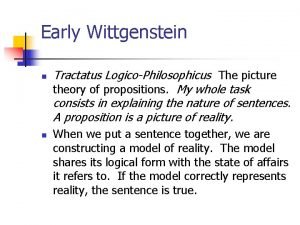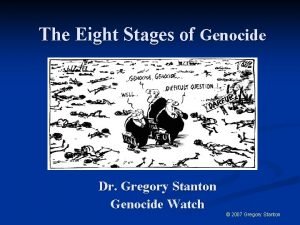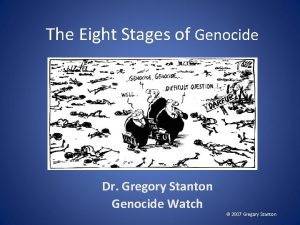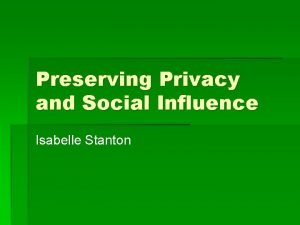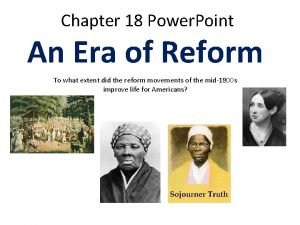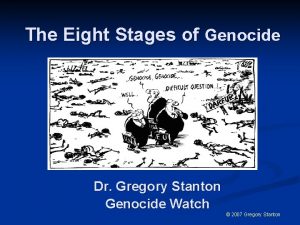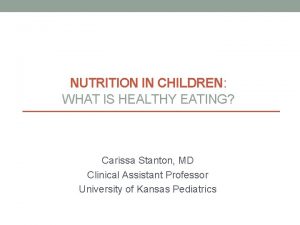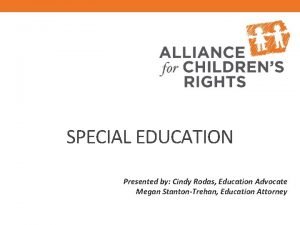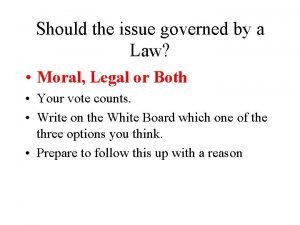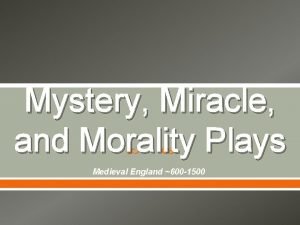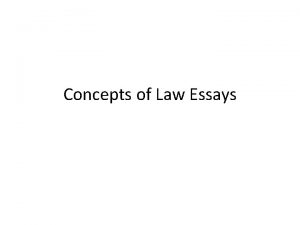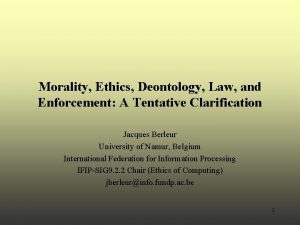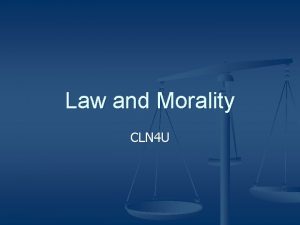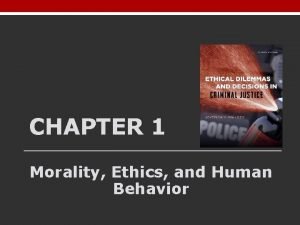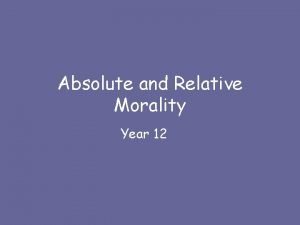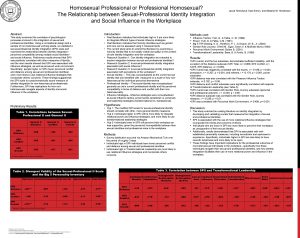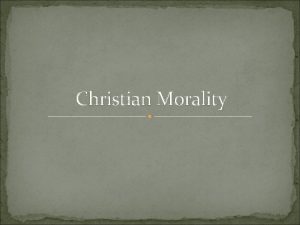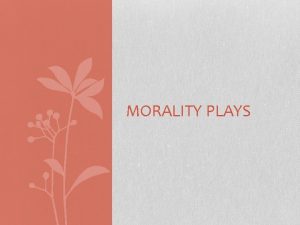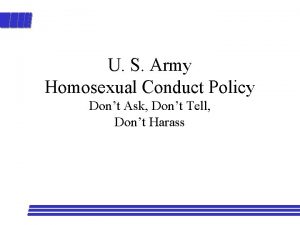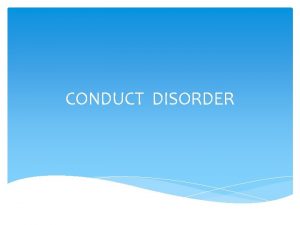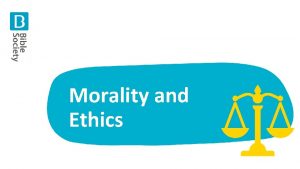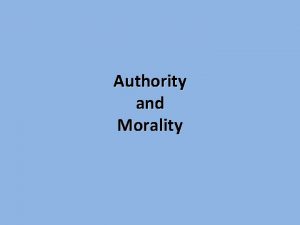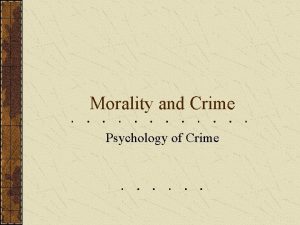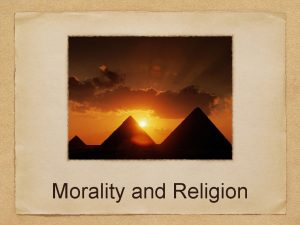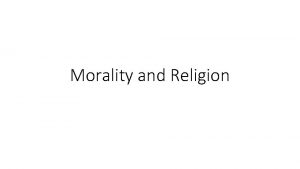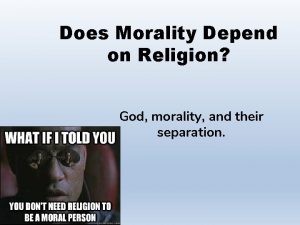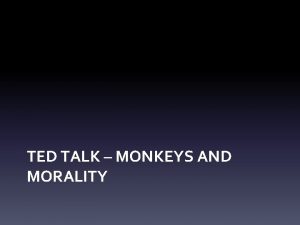Science and the Morality of Homosexual Conduct Stanton



























![QUOTE: Långström et al, 2010: “[Our] results are consistent with moderate, primarily genetic, familial QUOTE: Långström et al, 2010: “[Our] results are consistent with moderate, primarily genetic, familial](https://slidetodoc.com/presentation_image/2ab85c035c02fd804a915db67d2f7ce1/image-28.jpg)

























![American Psychiatric Association “[T]here is no published scientific evidence supporting the efficacy of ‘reparative American Psychiatric Association “[T]here is no published scientific evidence supporting the efficacy of ‘reparative](https://slidetodoc.com/presentation_image/2ab85c035c02fd804a915db67d2f7ce1/image-54.jpg)








- Slides: 62

Science and the Morality of Homosexual Conduct Stanton L. Jones, Ph. D. Wheaton College

Major challenges to traditional view: n. Call to love and acceptance n. Supposed silence of Scripture n“New ethical truth” (e. g. , Gentiles, divorce) n. Spirituality among gays n. New truth from Science

Why Engage Science? Two Divergent Christian Motivations n As an exercise in Natural Theology or Natural Ethics. Presumes: Reason can lead to a consensus ethic apart from Revelation. Method: Inductive Goal: Establish homosexual conduct as wrong (or right) via reason

Why Engage Science? Two Divergent Christian Motivations n Natural Theology/Natural Ethics, or n Apologetic Defense of Revealed Ethic. Presumes: Science and Ethics are not disconnected, but relationship is complex. Method: Review science on science’s terms; examine logic of application of science to moral questions. Goal: Responsible engagement of Science and Theology/Ethics

Why Engage Science? Two Divergent Christian QUESTIONS n Natural Theology or Natural Ethics. “Does Science Prove (or Validate) Natural Ethics? ” n Apologetic Defense of Revealed Ethic. “Does Science Disprove (or Invalidate) Revealed Ethics? ”

Challenging “Scientific” Assertions n being gay is as healthy as being straight; n sexual orientation is a biologically determined given, environmental variables contribute nothing; n sexual orientation cannot be changed, the attempt to change is intrinsically harmful; n homosexual relationships are equivalent; n identity is properly grounded in sexual orientation.

To respond to claims of “Science says. . . ”, we must n Ascertain the real findings of science (and never accept “press release” science reports) and critique these studies with care n Examine carefully the logic by which the findings of science are applied to the moral question

Quote re: “Gay Fruit Flies” 6/05 Human Rights Campaign "Science is closing the door on right-wing distortions. . The growing body of scientific evidence continues to refute the opponents of equality who maintain that sexual orientation is a ‘choice’” (“the largest national lesbian, gay, bisexual and transgender political organization”)

Quote re: “Gay Fruit Flies” 6/05 This study “will take the discussion about sexual preferences out of the realm of morality and put it into the realm of science. ” Dr. Michael Weiss, Chairman of the Case Western Reserve University Department of Biochemistry, in the New York Times

The Great Weakness of Homosexuality Research n Inability to identify a representative sample of GLB persons n Statistical infrequency contributes to this problem n Further compounded by definitional issues: “who counts? ” n Leads to severe problems with “volunteer bias”

Etiology of Homosexuality Biologically-Determined, right? !?

Background on Brain Studies: n There has been a pattern of publicized findings that have never been replicated n Brain differences may or may not be genetic n Brain differences may be either cause or effect of behavioral/psychological differences n Hypothalamus regulates some sexual behavior and other functions

Le. Vay reported that the INAH 3 of heterosexual females was significantly smaller than that of heterosexual males, AND on average the INAH 3 of homosexual males was like that of heterosexual females and significantly smaller than for heterosexual males Het. M>(Het. F & Hom. M)

Problems with Le. Vay’s study: n Classification: Subjects presumed heterosexual unless explicitly noted in medical files n Many subjects, heterosexual and homosexual, died of AIDS n Many had been treated with adrenergic drugs; influence on brains? n Reports circulated for years of failures to replicate

William Byne et al. (2000, 2001): n Careful sampling; equivalent samples n Replicated that the INAH 3 of heterosexual females was significantly smaller than that of heterosexual males n Determined that the male-female INAH 3 size difference was due to number of neurons in that region

William Byne et al. (2000, 2001): n Found homosexual males to be intermediate between heterosexual females and heterosexual males in INAH 3 size; not significantly different than either n Found homosexual and heterosexual males to have the same number of neurons in INAH 3 (homosexuals were like the heterosexual males, and unlike the females)

QUOTE: Byne et al, 2001: “Sexual orientation cannot be reliably predicted on the basis of INAH 3 volume alone . . . sex related differences may also emerge later in development as the neurons that survive become part of functional circuits. ” The difference in INAH 3 volume could be attributed to “a reduction in neuropil within the INAH 3 in the homosexual group” as a result of “postnatal experience. ”

Behavioral Genetics Basic Logic of Behavioral Genetics: If a behavioral or psychological pattern is influenced by genetics, then individuals who are more genetically similar should also be more behaviorally or psychologically similar than individuals who are less genetically similar.

Bailey and Pillard (1991) found (males): Identical (monozygotic) 52% Probandwise twins Concordance; “ 29/56” Fraternal (dizygotic) twins 22% Probandwise Concordance; “ 12/54” Nontwin brothers 9% Probandwise Concordance; “ 13/142” Adopted brothers 11% Probandwise Concordance; “ 6/57”

Here is what the public THINKS Bailey and Pillard found (“ 29/56”): 56 twin pairs total, of which there were 29 “matched” twin pairs (where both twins were gay): - | - | - | - | - | - - | - | - 27 “non-matched” twin pairs (where only one twin was gay): - | - | - | - | - | - - | -

Here is what Bailey and Pillard ACTUALLY found: 41 twin pairs total, of which there were 13 “matched” twin pairs (where both twins were gay): - | - | - | - 1 triplet trio “match, ” where all three triplets were gay: - - 27 “non-matched” twin pairs (where only one twin was gay): - | - | - | - | - - | - | - TOTAL OF 56 HOMOSEXUAL INDIVIDUALS IN 41 SIBLING RELATIONSHIPS

Bailey & Pillard Problems n Crucial Methodological Problem: Method of obtaining sample by ads in openly pro-gay magazines creates possibility of volunteer sample bias n The decisive refutation: from Bailey, Dunne & Martin (2000) himself: – Sample drawn from the Australian twin registry – “Probandwise concordance” dropped from 52% to 20% for identical twins

Here is what Bailey, Dunne and Martin (2000) found: 27 twin pairs total, of which there were 3 “matched” twin pairs (where both twins were gay): - | - 24 “non-matched” twin pairs (where only one twin was gay): - | - | - | - | - | - | - | -

QUOTE: Bailey et al, 2000: The new study “did not provide statistically significant support for the importance of genetic factors” in causing homosexual orientation. “This suggests that concordances from prior studies [i. e. , his own two prior studies] were inflated due to concordance dependent ascertainment bias. ”

New Research (2010) Reinforces Small Genetic Contribution: N. Långström, Q. Rahman, E. Carlström, & P. Lichtenstein (2010), “Genetic and Environmental Effects on Same-Sex Sexual Behavior: A Population Study of Twins in Sweden, ” Archives of Sexual Behavior, 39, 75 -80. “Previous studies employed self-selected, opportunistic, or small population-based samples. [In contrast, their study] used data from a truly population-based survey of all adult twins in Sweden to conduct the largest twin study of same sexual behavior attempted so far. ”

QUOTE: Långström et al, 2010:

Långström, N. , Rahman, Q. , Carlström, E. , & Lichtenstein, P. “Genetic and Environmental Effects on Same-sex Sexual Behavior: A Population Study of Twins in Sweden. " Archives of Sexual Behavior, 2010: : 71 twin pairs total, of which there were 7 “matched” twin pairs (where both twins were gay): - | - | - | - 64 “non-matched” twin pairs (where only one twin was gay): - | - | - | - | - | - | - | - - | - | - | - | - | - | - | - TOTAL OF 78 HOMOSEXUAL INDIVIDUALS IN 71 SIBLING RELATIONSHIPS 14 MATCHES OUT OF 78 GAY MEN = 18% PC
![QUOTE Långström et al 2010 Our results are consistent with moderate primarily genetic familial QUOTE: Långström et al, 2010: “[Our] results are consistent with moderate, primarily genetic, familial](https://slidetodoc.com/presentation_image/2ab85c035c02fd804a915db67d2f7ce1/image-28.jpg)
QUOTE: Långström et al, 2010: “[Our] results are consistent with moderate, primarily genetic, familial effects, and moderate to large effects of the nonshared environment [i. e. , familial, social and other effects]. ”

One last biological hypothesis. . . n Brain studies n Behavioral genetics n Direct gene scanning <skipped> n “Older brother hypothesis” <skipped> n “Homosexuality as a Consequence of Epigenetically Canalized Sexual Development” Rice et al, Quarterly Review of Biology, 12/2012

Direct Hormonal Effect on Gender Characteristics Model XY SRY testes Hi T Masculinization XX no SRY ovaries Lo T Feminization Inadequate Model?

Hypothetical Fetal Circulating Testosterone Lower Female Higher Male

XY SRY testes Hi T Masculinization XX no SRY ovaries Lo T Feminization INDIRECT MODEL epi-marks= T hypersens XY SRY testes Hi T Masculinization epi-marks= T hyposens XX no SRY ovaries Lo T Feminization

Epigenetically Canalized Sexual Development: Actual Evidence? “Although we cannot provide definitive evidence that homosexuality has a strong epigenetic underpinning, we do think available evidence is fully consistent with this conclusion. ” -- Rice et al. , p. 357

Epigenetically Canalized Sexual Development: Potential problems n Directly reliant on assumption of maternal transmission of male homosexuality and paternal transmission of female homosexuality; neither solidly proven n Counts on corroboration from data showing greater fecundity of relatives of Gays & Lesbians; actual data quite mixed n Assumes pure biological programming of sexual preference

Etiology of Homosexuality No evidence of non-biological causes, right? !? Two recent studies. . .

Bearman & Brückner (2002) American Journal of Sociology, 107 (5) n National representative sample of over 30, 000 US adolescents. n “we show that adolescent male opposite-sex (hereafter OS) twins are twice as likely as expected to report same-sex attraction, and that the pattern of concordance (similarity across pairs) of same-sex preference for sibling pairs does not suggest genetic influence independent of the social context. ” - Bearman & Brückner (2002; p. 1181)

Bearman & Brückner (2002) findings: Relationship % with Sexual Attraction N (all males) Opposite sex twin 16. 8% 185 Same sex twin DZ 9. 8% 276 Same sex twin MZ 9. 9% 262 Opposite sex full sibling Same sex full sibling Other (nonrelated, half-siblings) 7. 3% 427 7. 9% 596 10. 6% 832 Bearman & Brückner (2002)

QUOTE n “Our data falsify the hormonal transfer hypothesis, by isolating a single condition that eliminates the OS effect we observe—the presence of an older same-sex sibling. . In contrast, our results support the hypothesis that less gendered socialization in early childhood and preadolescence shapes subsequent same-sex romantic preferences. ” - Bearman & Brückner (2002; p. 1181)

QUOTE “The findings presented here confirm some findings from previous research and stand in marked contrast to most previous research in a number of respects. First, we find no evidence for intrauterine transfer of hormone effects on social behavior. Second, we find no support for genetic influences on same-sex preference net of social structural constraints. Third, we find no evidence for a speculative evolutionary model of homosexual preference [the older-brother findings]. Finally, we find substantial indirect evidence is support of a socialization model at the individual level” - (Bearman & Brückner; p. 1199)

Frisch & Hviid (October, 2006) Archives of Sexual Behavior n Title: “Childhood family correlates of heterosexual and homosexual marriages: A national cohort study of two million Danes ” n “Because we do not know how representative men and women in same-sex marriages are of homosexuals in general, our findings should not be used incautiously to define childhood determinants of sexual orientation. ”

Frisch & Hviid (October, 2006) Archives of Sexual Behavior n “Our analysis therefore provides population-based, prospective evidence that a variety of childhood family experiences bear importantly of both heterosexual and homosexual mating patterns in adulthood. ” Examples of variables: being born in urban areas, and for men, “having older mothers, divorced parents, absent fathers”

Frisch & Hviid (October, 2006) Archives of Sexual Behavior n argued that much of the older brother research is based on “notoriously unrepresentative homosexual samples, ” n “our findings regarding the impact of siblings of homosexual marriages in men raise questions as to the universality of the fraternal birth order hypothesis for male homosexuality… we found no indication that older brothers were particularly common in these homosexual men. Rather, older siblings, whether brothers or sisters, were positively and linearly linked to higher rates of heterosexual marriage in our study”

Logic of Application to Moral Debate

QUOTE: Richard Hays, in The Moral Vision of the New Testament: The Bible’s sober anthropology rejects the apparently commonsense assumption that only freely chosen acts are morally culpable. Quite the reverse: the very nature of sin is that it is not freely chosen. That is what it means to live “in the flesh” in a fallen creation. We are in bondage to sin but still accountable to God’s righteous judgment of our actions. In light of this theological anthropology, it cannot be maintained that a homosexual orientation is morally neutral because it is involuntary. ”

The Question of Change Unchangeable, right? !?

Counter-Argument on Change I: “Change of behavior is always possible. God holds people responsible for their actions (which they choose) not their proclivities (many of which they do not choose)”

Counter-Argument on Change II: Dozens of studies have been published documenting that change is possible for some via therapeutic and religious means. No scientific studies exist that refute those studies. The studies are dismissed based on methodological criticism, cynicism, and negative anecdotes.

Research on Change Study Modality N #PO %PO Source Change Reported †Bieber (1962) Individual 106 29 27 Analyst-Report Hom. Beh. ; Het. Beh. Birk (1974) Group 66 14 21 Therapist-Report Het. Beh. or marriage Cantom. Dutari (1976) Individual 54 11 20 Client-Report Hom. Beh; Het. Beh. Hadden (1966) Group 32 12 38 Analyst-Report Hom Be/Attr; Het Beh/Att/O Johnsgard & Schumacher (1970) Group 5 ---- Therapist-Report ---†‡Kaye et al. (1967) Individual 24 6 25 Analyst-Report Orientation (Kinsey-like) Mac. Culloch & Feldman (1967) Individual 43 25 56 Client-Report Hom/Beh/Fa. ; Het/Beh/Fa (Kinsey Scale) Orientation (Kinsey scale) †Mac. Intosh (1994) Individual 1215 276 23 Analyst-Report Hom. Beh. ; Het. Beh. , Attr. Mc. Conaghy (1970) Individual 40 10 25 Client-Report Hom. Beh. ; Het. Beh. , Attr. (Penile vol. ) ( Hom. Attr. ) Mintz (1966) Group 10 3 30 Analyst-Report Hom. Beh. , Attr. ; Het. Beh. , Attr. ; Orientation Pittman & De. Young (1971) Group 6 3 50 Therapist-Report Hom. Beh. ; Het. Beh. *Truax & Tourney (1971) Group 30 20 67 Client-Report Hom. Beh/Fa; Het. Beh/Fa. van den (Analyst-Report) (“improved”) Aardweg (1986) Individual 101 37 Analyst-Report Hom. Beh. , Attr. Het. Beh. , Attr.

Robert Spitzer Archives of Sexual Behavior (2003): Studied sample of 200 self-defined success cases (143 males, 57 females). Spitzer found that a majority of participants reported shifting from a predominantly or exclusively homosexual orientation before therapy to a predominantly or exclusively heterosexual orientation in the year prior to their interview. Most significantly, change was reported in variables that are considered fairly static dimensions of sexual orientation, including sexual attraction, arousal, fantasy, and yearning.

III: Jones and Yarhouse (2007, 2011) Stanton L. Jones & Mark A. Yarhouse, Journal of Sex and Marital Therapy, 2011, 37, 404 -427

Two Key Issues: n. Is change possible? n. Is attempted change harmful?

American Psychological Association: “What About So-Called ‘Conversion Therapies’ ? ” “. . . claims are poorly documented. For example, treatment outcome is not followed and reported over time as would be the standard to test the validity of any mental health intervention. ” http: //www. apa. org/pubinfo/answers. html

American Psychological Association: “What About So-Called "Conversion Therapies"? (contd. ) “The American Psychological Association is concerned about such therapies and their potential harm to patients. ” http: //www. apa. org/pubinfo/answers. html
![American Psychiatric Association There is no published scientific evidence supporting the efficacy of reparative American Psychiatric Association “[T]here is no published scientific evidence supporting the efficacy of ‘reparative](https://slidetodoc.com/presentation_image/2ab85c035c02fd804a915db67d2f7ce1/image-54.jpg)
American Psychiatric Association “[T]here is no published scientific evidence supporting the efficacy of ‘reparative therapy’ as a treatment to change one’s sexual orientation. The potential risks of ‘reparative therapy’ are great, including depression, anxiety and self-destructive behavior. ” www. psych. org/archives/news_room/press_releases/rep_therapy. cfm

Exodus International n a “worldwide interdenominational, Christian organization called to encourage, strengthen, unify and equip Christians to minister the transforming power of the Lord Jesus Christ to those affected by homosexuality. ” n “Freedom from homosexuality through the power of Jesus Christ. ”

Standards for Scientific Excellence: n Prospective Design n Longitudinal Design n Representative Sample n Utilize Best Self-Report Measures of Sexual Orientation n Large Subject Population n Sample different Exodus groups

Qualitative Categories of Outcomes: n Success: Conversion (to Heterosexuality) n Success: Chastity (“Freedom to live chaste”) n Continuing Change n No Response n Failure: Confused n Failure: Gay Identity

Outcome Results

RESULTS: Is Change Harmful?


Conclusion: Is Change Possible? Yes, to some degree, for some. Is Attempt to Change Harmful? On average, no.

Conclusion: What Are We To Do? Manifest Love Live the Truth
 Toc homosexual
Toc homosexual Nietzsche master morality
Nietzsche master morality Master morality vs slave morality
Master morality vs slave morality Slave mentality
Slave mentality Barney by will stanton
Barney by will stanton My favorite subject science
My favorite subject science Marion stanton
Marion stanton Dr gregory stanton
Dr gregory stanton Eight stages of genocide
Eight stages of genocide Stanton chase
Stanton chase Isabelle stanton
Isabelle stanton Elizabeth cady stanton with my eyes i see
Elizabeth cady stanton with my eyes i see Stanton exterminator
Stanton exterminator Stanton chase panama
Stanton chase panama Marion stanton
Marion stanton Stanton elementary school
Stanton elementary school Stanton cross masterplan
Stanton cross masterplan Gay chastity
Gay chastity Gretchen stanton
Gretchen stanton Stanton greer
Stanton greer Stanton alarm system
Stanton alarm system Edward stanton
Edward stanton Carissa stanton md
Carissa stanton md Nusselt number laminar flow in tube
Nusselt number laminar flow in tube Megan stanton-trehan
Megan stanton-trehan Difference between law and morality
Difference between law and morality Mystery plays and morality plays
Mystery plays and morality plays Difference between morality and law
Difference between morality and law Difference between law and morality
Difference between law and morality Differences between law and ethics
Differences between law and ethics Law and morality
Law and morality Law and morality
Law and morality Do ethics and morality ever conflict
Do ethics and morality ever conflict Law and morality
Law and morality Natural moral law
Natural moral law Ethics vs morals
Ethics vs morals Agape is
Agape is Hình ảnh bộ gõ cơ thể búng tay
Hình ảnh bộ gõ cơ thể búng tay Ng-html
Ng-html Bổ thể
Bổ thể Tỉ lệ cơ thể trẻ em
Tỉ lệ cơ thể trẻ em Gấu đi như thế nào
Gấu đi như thế nào Glasgow thang điểm
Glasgow thang điểm Bài hát chúa yêu trần thế alleluia
Bài hát chúa yêu trần thế alleluia Môn thể thao bắt đầu bằng từ chạy
Môn thể thao bắt đầu bằng từ chạy Thế nào là hệ số cao nhất
Thế nào là hệ số cao nhất Các châu lục và đại dương trên thế giới
Các châu lục và đại dương trên thế giới Công của trọng lực
Công của trọng lực Trời xanh đây là của chúng ta thể thơ
Trời xanh đây là của chúng ta thể thơ Mật thư tọa độ 5x5
Mật thư tọa độ 5x5 101012 bằng
101012 bằng độ dài liên kết
độ dài liên kết Các châu lục và đại dương trên thế giới
Các châu lục và đại dương trên thế giới Thể thơ truyền thống
Thể thơ truyền thống Quá trình desamine hóa có thể tạo ra
Quá trình desamine hóa có thể tạo ra Một số thể thơ truyền thống
Một số thể thơ truyền thống Cái miệng bé xinh thế chỉ nói điều hay thôi
Cái miệng bé xinh thế chỉ nói điều hay thôi Vẽ hình chiếu vuông góc của vật thể sau
Vẽ hình chiếu vuông góc của vật thể sau Thế nào là sự mỏi cơ
Thế nào là sự mỏi cơ đặc điểm cơ thể của người tối cổ
đặc điểm cơ thể của người tối cổ V cc cc
V cc cc Vẽ hình chiếu đứng bằng cạnh của vật thể
Vẽ hình chiếu đứng bằng cạnh của vật thể Phối cảnh
Phối cảnh



